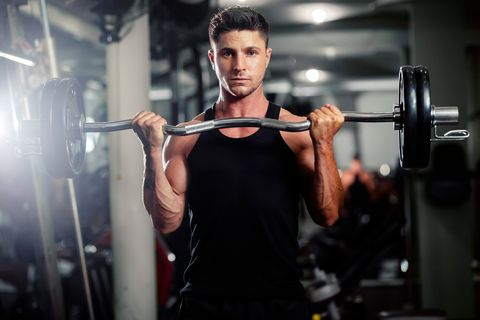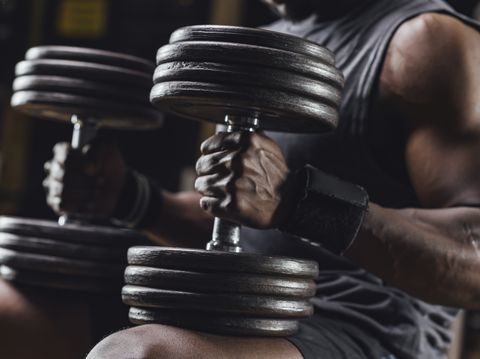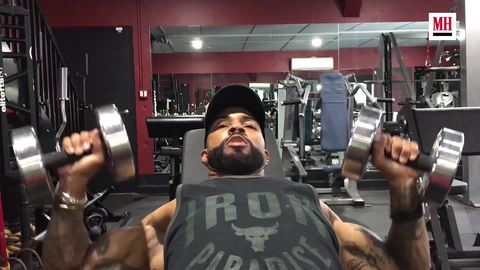When you start lifting weights, the easiest, most logical way to progress through your workout plan is by taking on every movement in your routine with straight sets. You need to focus on your form, and it should be challenge enough to put as much effort as possible into each individual rep. Once you’re more experienced and your newbie gains are behind you, however, you’ll find that there’s more than one approach to splitting up your working sets than just running straight through with a reps, rest, and repeat approach. That’s when you can turn to different training protocols—namely, the superset.
The superset might sound like the title of a comic book hero’s workout, but it’s actually a fairly simple concept once you put it into practice. You’ll double up your exercises, and instead of the standard reps, rest, and repeat setup outlined above, you’ll add an extra step: reps of exercise one, immediately move to reps of exercise two, rest, and repeat.
This super efficient approach is also super popular with lifters of all stripes. Everyday trainees use supersets to cut down on their total training time and increase their total work capacity, while heavy volume-focused bodybuilders implement the protocol into their splits to ramp up their time under tension while working to maximize their hypertrophy gains. Performance-minded athletes will even double-up their exercises in complimentary pairs to capitalize on strength and power adaptations, utilizing more advanced techniques like contrast training.
All that is to say that supersets are an essential strength and conditioning strategy that you should have in your training tool kit. Whether you’re trying to shave some precious minutes off your workout on an extra-packed day working to make your lift as efficient as possible, you’ll benefit from implementing the protocol into your plans.
Let’s break down the following topics for a greater understanding of the superset:
●What Is a Superset?
●How Should I Use Supersets?
●When Should I Use Supersets?
●Benefits of Using Supersets
●Who Should Use Supersets?
What Is a Superset?
A superset refers to two exercises performed back-to-back, with little or no rest in between. The practice can help to cut your workout time roughly in half, since you’re only resting once you’ve finished two moves, rather than taking time between every single set for just one exercise. If creating quick workouts meant to build muscular endurance and metabolic conditioning in the weight room is your goal, supersets will be your best friend.
Here’s an example of a basic lower body superset:
You can use supersets in the broadest sense and stack any two moves to simply cut down on your workout time. If you’re extra savvy, you can select complementary exercises that target opposing muscle groups in order to make your workout more efficient.
You might, say, aim at combining moves where you push with moves where you pull; an example of this would be an overhead press with a pullup. You’re resting the muscles that you depend on to push the barbell while you’re doing the pullups, and vice versa, so there’s very little wasted time involved—with all the work you’d get by performing the moves in a more standard format.
How Should I Use Supersets?
The most obvious time to implement supersets is when you want to cut down your workout time. Be careful to remember that not every move is ideal to be part of a pair, however.
“When I do use supersets in body part workouts, I let them come into play after getting any ‘heavy’ work out of the way,” says Men’s Health Fitness Director Ebenezer Samuel, C.S.C.S. “I wouldn’t want to bench heavy and [then] row.”
While it’s not a bad thing to value your time and program your workouts to be as quick and efficient as possible, you should never design a routine built around heavy lifts with speed as your number one priority. If you’re going to perform compound exercises with large loads, you’ll need proper rest time between sets to fully recover for the next set. Sometimes, deciding which moves you’ll be able to perform to the best of your ability in the superset format is something you need to determine on your own.
“Part of that is mental,” continues Samuel. “Can you really focus on your technique and neural drive while doing a heavy bench, then transitioning to a heavy row? Not sure [if I could], and I’d contend there are diminishing returns there, so I generally don’t recommend or program that.”
Instead of front loading the big lifts like back squats, bench presses, and deadlifts with accessory moves that will ultimately sap your performance, give them your full attention. Then, partner up corresponding exercises that don’t require as much rest for recovery.
“My standard chest workout goes with a flat press of some sort, followed by an incline press,” Samuel says. “Then I superset a fly and a focus-style pushup — [like] an archer or decline with a squeeze.”
When Should I Use Supersets?
Your goals for training should also factor into your decision to use supersets. The method is not quite a one-size-fits-all time saver.
“If you’re aiming for size or working to improve overall power via low-rep patterns, they may not serve you well,” Samuel advises.
This comes back to recovery. If you’re training to build raw strength with a goal to lift as much weight as possible, you’re going to need to rest to prep for the next set. The National Strength and Conditioning Association (NSCA) recommends rest periods between 2 to 5 minutes for 1 to 5 reps of >85 percent of your 1 rep max (1RM) when training to build strength, so you’ll only hurt your chances of finishing your lifts if you spend rest periods pumping up another muscle group.
If you’re looking to induce muscle growth through hypertrophy, the cellular process through which your muscle repairs itself, supersets might not be your absolute best bet, either. The NSCA recommended splits for that goal is 6 to 12 reps at 65 to 85 percent of 1RM, with 60 second rest periods. You can program a superset to time up for that format — and many coaches do recommend supersets for hypertrophy, including the NCSA itself — but you might want to utilize the rest period more carefully for maximal performance instead.
To really pound a muscle group when you’re training for volume, you can also try compound sets, which pair two exercises within the same muscle group together. Rest for a minute between your compound sets, and you can kick-start muscle growth for super gains within the recommended framework for hypertrophy.
Benefits of Using Supersets
So, you want to use supersets, but you want to make sure they’re worth your time and effort. Here are three benefits that can come along with using supersets.
1. Decreased Total Workout Time
Supersets are awesome because they can cut down your total time working out. This is great for all the busy lifters and athletes that want to put in the work and abide by their hectic schedules. If you find yourself in a time crunch, try adding supersets for your accessory work to work faster but still achieve your total workout volume.
2. Increased Total Work Capacity
Work capacity entails performing a goal-driven amount of work in a set time frame, then recovering from that work and progressively adapting. Lifters that want to improve their means of performing high volumes of work in less time can find benefits using supersets, as they naturally increase the amount of work performed within a given set.
3. Beefed Up Hypertrophy Gains
On top of decreasing total workout time, supersets can also benefit hypertrophy adaptations. By using back-to-back similar muscle group focused exercises we can push ourselves closer to failure and recruit more muscle fibers as effort increases throughout the superset.
Note, the one caveat to this benefit is that you need to be strategic with your programming because too much back-to-back muscle group superset training can cause a faster rate of fatigue accumulation. Ideally, perform these supersets toward the end of your workout.
Who Should Use Supersets?
As discussed above, supersets can be used by a wide range of lifters. What’s most important when considering the “who” with supersets is the acknowledgment of the “how”. This means using a strategy with supersets and not haphazardly programming because they look cool.
- Busy Lifters That Want to Cutdown Workout Time
Any lifter that needs to get through their workouts fast can and should use supersets. Ideally, they’ll want to perform upper-lower or agonist-antagonist supersets.
- Athletes Who Want to Improve Power
Athletes that want to improve their power output can experiment with the use of superset. Generally, same or similar muscle group supersets will be the preferred option for this demographic.
- Lifters That Want to Increase Their Hypertrophy
Lifters that want to recruit more muscle fibers and edge closer to exhaustion can use supersets. Oftentimes, lifters will employ same or similar muscle group supersets to increase hypertrophy by increasing total time under tension muscles are under.
Brett Williams, a fitness editor at Men’s Health, is a NASM-CPT certified trainer and former pro football player and tech reporter who splits his workout time between strength and conditioning training, martial arts, and running. You can find his work elsewhere at Mashable, Thrillist, and other outlets.
Jake Boly, MS CSCS, is the Co-Founder of Pheasyque Lab, That Fit Friend, and works as a consultant for other fitness professionals trying to build websites and brands.
This content is imported from OpenWeb. You may be able to find the same content in another format, or you may be able to find more information, at their web site.






Comments are closed.